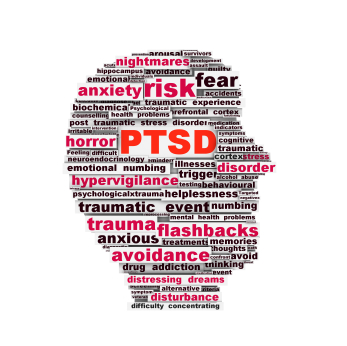One Doctor’s Protocol for the Treatment of Severe PTSD
 Note: The following article discusses “off-label” treatments for the treatment of PTSD or traumatic brain injury, i.e. those which are not FDA-approved for these purposes. In some of these instances, there is no controlled research to support the use of these drugs in patients with PTSD. Thus the ideas noted here cannot be taken as anything more than anecdotal information from personal experience. Patients and physicians must make their own decisions about any of the strategies reported in this or other issues of BNN.
Note: The following article discusses “off-label” treatments for the treatment of PTSD or traumatic brain injury, i.e. those which are not FDA-approved for these purposes. In some of these instances, there is no controlled research to support the use of these drugs in patients with PTSD. Thus the ideas noted here cannot be taken as anything more than anecdotal information from personal experience. Patients and physicians must make their own decisions about any of the strategies reported in this or other issues of BNN.
At a recent scientific conference, Vaishali P. Bakshi, a renowned Canadian psychopharmacologist, shared a novel treatment strategy he has developed for patients with exceptionally profound degrees of post-traumatic stress disorder (PTSD), which, particularly among military veterans, can be compounded by traumatic brain injury.
Treatment options based on placebo-controlled clinical trials are sometimes insufficient for the treatment of seriously ill patients. FDA-approved treatment for PTSD consists of serotonin-selective antidepressants, while exposure therapies (in which the patient is gradually exposed to more of the stimuli that triggered symptoms) are the recommended psychotherapy, but these methods often leave patients highly disabled.
Bakshi’s typical treatment algorithm goes well beyond these treatment guidelines to find solutions for hard-to-treat patients. He first addresses sleep disturbance, which often occurs in PTSD. He suggests the anticonvulsant levetiracetam (Keppra), starting at doses of 150mg per night and increasing to 500–1000mg as tolerated. This highly sedating anticonvulsant not only improves sleep but may also help cognition, since it is structurally similar to other cognitive enhancers such as piracetam. Levetiracetam also decreases the hippocampal hyperactivity associated with some forms of cognitive dysfunction, as we’ve noted before. In order to further enhance sleep effects, Bakshi adds trazodone at 50–150mg per night as needed.
Instead of selective serotonin reuptake inhibitors (SSRIs), Bakshi recommends the selective serotonin and norepinephrine reuptake inhibitors (SNRIs). Among these, he prefers desvenlafaxine (Pristiq) over venlafaxine, as desvenlafaxine has fewer interactions with other drugs. Theoretically, duloxetine (Cymbalta) is another SNRI that could be used.
Another component of Bakshi’s treatment plan is topiramate (Topamax), which can target many comorbidities of PTSD, including alcohol and substance abuse, particularly stimulant abuse. In addition, topiramate has efficacy in anger attacks, which often accompany PTSD.
In patients with ongoing problems with depression and/or cognition, Bakshi adds bupropion (Wellbutrin). Bupropion enhances dopamine levels in the nucleus accumbens, thus adding dopamine effects to the serotonin and noradrenergic effects of the SNRIs.
If patients remain symptomatic with depression, anger, irritability, or flashbacks, Bakshi then recommends adding lamotrigine (Lamictal). Lamotrigine has anti-glutamatergic effects, decreasing release of glutamate, the major excitatory neurotransmitter in the brain. Thus, while levetiracetam enhances the actions of the inhibitory neurotransmitter GABA, lamotrigine decreases glutamatergic over-excitation; thus providing a dual mechanism for decreasing the neuronal hyperexcitability and reactivity that can occur with PTSD.
If mood remains dysregulated, Bakshi sometimes augments the above regimen with lithium carbonate.
Editor’s Note: Bakshi’s treatment regimen is meant to target multiple neurotransmitter systems with moderate doses of a range of drugs that are not conventionally used or recommended in treatment guidelines for the treatment of PTSD. We highlight this treatment strategy he has used to treat many patients because too often patients with serious disability from PTSD are under-treated, and many elements of their symptomatology go unaddressed. Bakshi indicated that his treatment plan often takes several months to show notable clinical effects, but he reports that he often sees dramatic clinical improvement in symptoms of both PTSD and traumatic brain injury.
In addition to Bakshi’s suggested treatment regimen, there are other potentially useful treatments for PTSD. The positive effects of prazosin, a noradrenergic alpha-1 receptor antagonist, are well documented in placebo-controlled trials by Murray Raskind et al. Prazosin is able to selectively inhibit nightmares associated with PTSD while leaving normal dreaming uninterrupted.
N-acetylcysteine (NAC) is also worthy of consideration in the treatment of PTSD, as it has shown efficacy in both unipolar and bipolar depression, anxiety disorders, and addictions, including cocaine, heroin, marijuana and gambling, all of which are common in PTSD.
Another theoretical treatment that deserves study would be augmentation of lamotrigine with memantine (Namenda), as in 2012 Anand et al. reported that memantine increased the antidepressant effects of lamotrigine in the initial weeks of treatment. Memantine also improved mood stability in patients with treatment-resistant bipolar disorder in a study by Koukopoulos et al. in 2012. In addition, as an FDA-approved treatment for memory loss in Alzheimer’s disease, memantine holds the (as yet unstudied) possibility of helping treat the memory loss that often accompanies both PTSD and traumatic brain injury.

